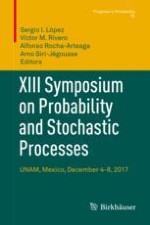2020 | Book
XIII Symposium on Probability and Stochastic Processes
UNAM, Mexico, December 4-8, 2017
Editors: Sergio I. López, Víctor M. Rivero, Alfonso Rocha-Arteaga, Arno Siri-Jégousse
Publisher: Springer International Publishing
Book Series : Progress in Probability
